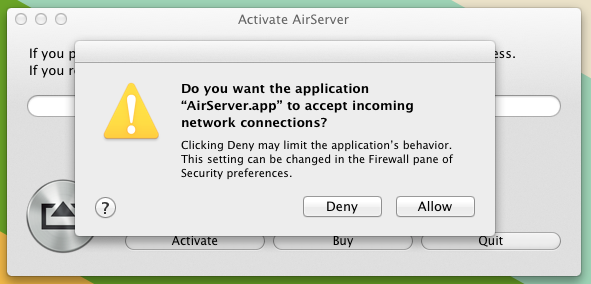
The aspect of the Mirrored display may have to be altered if full-screen mode is invoked, if the Mirrored display is cropped or stretched in an ugly way.

You can also look for the AirPlay logo in whatever app you want to mirror (e.g.

#AIRSERVER FOR MAC UPDATE#
UPDATE 2: AirServer 4.7.2 (imminent release) fixes some bugs in iOS7 related to pushing Passcode entry.īeware, if you lock the phone up, everyone can see your passcode as you unlock it! Mirroring doesn’t switch off just because the phone is locked. UPDATE: On iOS 7, AirPlay Mirroring moved to the Control Panel You can mirror an iOS device display by accessing the Task Switcher (double-press on Home button) and swiping all the way to the right. For example, on any iOS device go to Settings -> Wifi.
#AIRSERVER FOR MAC PC#
your iPhone, iPad, recent Macbook, or even a PC running an AirPlay client like AirParrot), connect to the Wifi network that you just created. The option “Onscreen password” works well. There is a panel under System Preferences for AirServer. It can be restarted from Applications, if needed. AirPlay runs over the same connection, so you can, for example, call up slides from Dropbox.ĪirServer runs at login, fairly silently. The easiest way to understand this function is that the Mac Mini is now additionally a wireless router you can connect to.īonus – sharing this connection means any device can get Wifi and see the Internet. The default is to share the Ethernet with devices over Wifi. There’s no way to keep the ad-hoc network secret (technically: the SSID broadcast cannot be disabled) and it doesn’t turn off automatically. Maybe not though….It makes sense to shut this off again after use. Although there is no obvious reason to put any security in a work environment, you might want to block your neighbour if you’re at home. On Mac Mini, turn on Wifi, make sure it doesn’t connect to any network and enable Internet Sharing. First you need to create an Ad-Hoc network between the Mac Mini and your device. AirServer is well known as a very robust app, but I thought I’d share the process. 3rd party solutions are available for non-Apple devices, see below. Later, I remembered I had already bought AirServer as part of the MacHeist NanoBundle 3 but that’s another story.Īfter installing on the Mac Mini that we normally use for hosting presentations, we can now beam data from an iPad, iPhone or any device that can send AirPlay data by following a few simple steps. The chance that our IT department would agree to installing a router for this purpose, or the utter uselessness of having to get each AirPlay client onto our Intranet, means that this idea is a non-starter.

#AIRSERVER FOR MAC TV#
Apple TV also wants to connect to the Internet. Whilst reasonable in a home environment, this arrangement isn’t ideal when it’s not your router. It connects to a router and all AirPlay data goes over the chain: Client -> Router -> Apple TV Unfortunately, I misunderstood that Apple TV cannot function as an Ad-Hoc access point. I anticipated being able to project from an iPad to make data sharing in meetings more fluid. I bought an Apple TV to connect to our beamer (what Germans call a projector) at work.


 0 kommentar(er)
0 kommentar(er)
